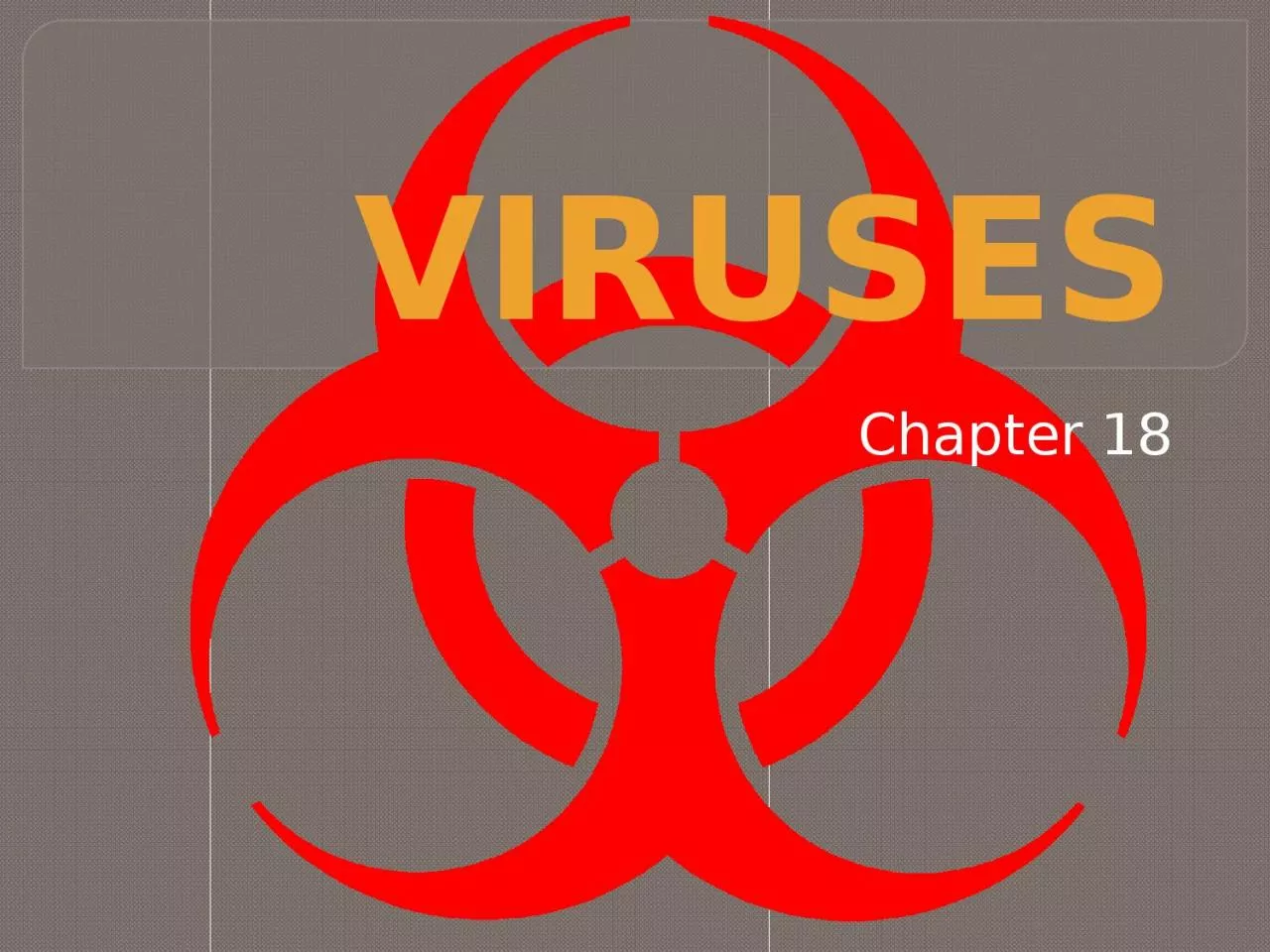

As a group discuss for 1 minute Be able to defend your answer for the class Are VIRUSES alive Growth and Development Reproduce Change Over Time Obtain and Use Energy Maintain Homeostasis ID: 930382
Download Presentation The PPT/PDF document "Viruses Chapter 18 Are Viruses Alive?" is the property of its rightful owner. Permission is granted to download and print the materials on this web site for personal, non-commercial use only, and to display it on your personal computer provided you do not modify the materials and that you retain all copyright notices contained in the materials. By downloading content from our website, you accept the terms of this agreement.
Slide1
Viruses
Chapter 18
Slide2Are Viruses Alive?As a group discuss for 1 minute. Be able to defend your answer for the class!
Slide3Are
VIRUSES alive?Growth and Development
Reproduce
Change Over Time
Obtain and Use Energy
Maintain Homeostasis
Composed of Cells
Respond to the Environment
Contain Genetic Material
Slide4VIRUS
: Latin word for
poison
Virus:
Non-living
,
parasitic, biological
particle.
All viruses cause some sort of disease. Some even cause cancer.
Slide5VIRUSES
do not “live” because:They can not reproduce outside a “host” cellThey do not carry out cellular
respiration
They do not
grow
or
develop
Slide6Virus structure
Nucleic AcidsDNA or RNA CoreHolds the genetic material that will affect the host
Proteins
An outer protein coat called a
Capsid
enables the virus to
enter
certain cells.
Slide7Virus structure
GlycoproteinsProjections that help the virus attach to hostNot all
viruses have
glycoproteins
.
Slide8Virus Size
Viruses are smaller than the smallest
cell
Slide9Virus Vocab
Host: a cell in which a virus replicatesHost Specific: most viruses or bacteria will only affect a
single
host or a small group of host species
Examples:
West Nile Virus – affects
birds
, horses, and
people
Influenza type B – affects only people not othersParvo
– affects only dogs, not other organisms
Slide10Types of Viruses
Slide11Bacteriophages
Slide12Phages
Viruses that attack bacteria are called bacteriophage or just phageT-phages are a specific class of bacteriophages with icosahedral heads, double-stranded DNA, and tails
Slide13T-phages
The most commonly studied T-phages are T4 and T7They infect E. coli
, an intestinal
bacteria
Six small spikes at the base of a contractile tail are used to
attach
to the host cell
Inject viral DNA into cell
Slide14Viruses Blow Up the Cell the Affect!!!
Once the viral genes get inside a cell, the genes are expressed.This genetic program causes the host cell to make copies of the virus.In the process, the host cell is destroyed.
Slide15Viruses Blow Up the Cell they Affect!!!
There are two ways this can occurThe Lytic CycleThe Lysogenic
Cycle
Slide16The Lytic Cycle
STEPSAttachVirus “docks” with host cellInjectionVirus inject it’s DNA/RNA into host
cell
Replicate
replication of virus
parts
Lysis
cell ruptures and new virus’ invade tissues of the host
Lysis
–
to break or rupture cells or cell membranes
Slide17The Lysogenic Cycle
STEPSAttachVirus “docks” with host cellInjectionVirus inject it’s DNA/RNA into host cell
Incorporate
DNA attaches to the cells own DNA
Time Goes By
Stress
Replicate
replication of virus parts
Lysis
cell ruptures and new virus’ invade tissues of the host
Slide18Examples of Lytic Viral Infections
1.
Common Cold
How do we catch it
?
Contact with contaminated objects; droplet inhalation
What are the symptoms
?
Sneezing, Sore Throat, Fever, Headache, Muscle
A
ches
Slide19Examples of Lytic Viral Infections
2. InfluenzaHow do we catch it?Contact with contaminated objects, droplet inhalation.What are the symptoms?Body Aches, Fever, Sore Throat, Nasal Congestion, Headache, Dry Cough, Fatigue.
Slide20Examples of Lytic Viral Infections
3. EbolaHow do we catch it?exposure to blood or bodily secretions of an infected person, or through direct contact with the person.What are the symptoms?Sore Throat, Fever, Dry hacking cough, Weakness, Severe Headache, Joint and muscle aches, Diarrhea, Dehydration, Stomach pain, vomiting, Internal and external bleeding.
Slide21Examples of
Lysogenic
Viral Infections
1.
Herpes Viruses
Once a person is infected with a herpes virus they are infected for life.
Examples:
Chicken Pox
can reappear later in life as
Shingles
HSV-1 (oral herpes) and HSV-2 ( genital herpes)
Slide22Example of a Retrovirus
2. HIV
How do we catch it
?
Contact with contaminated blood or bodily fluids
What are the symptoms
?
T cells (needed for normal immune function) are destroyed
Slide23Retroviruses
Retroviruses are viruses that contain RNA as their genetic informationRetroviruses get their name from the fact that their genetic information is copied backward, from RNA to
cDNA
.
HIV
is the most infamous retrovirus
Slide24How Do Our Bodies Fight Viral Infections?
Antibiotics do nothing for viral infections!!!After enough cell debris (from blown up cells) is detected your Immune system gets involved
Macrophages
are large white blood cells that get rid of debris by eating it.
When they eat too much, they die. These dead cells and the cell debris are “puss”
Slide25How Do Our Bodies Fight Viral Infections?
Other white blood cells pick up viral particles from the battle and carry it to Lymph nodes.In the lymph nodes, they look for cells to fight this type of virus.T- cells (thyroid cells
)
are called upon and go to the site of the infection to kill specific infected cells
B-cells
(
bursal
cells) make
antibodies that go to the site and kill free viruses
Slide26How Do Our Bodies Fight Viral Infections?
The best way to protect against most viral diseases lies in prevention, often by the use of vaccines.Most vaccines provide protection only if they are used
before
an infection begins.
Slide27